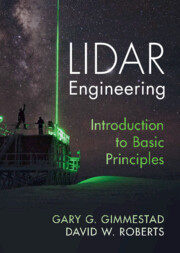Book contents
- Lidar Engineering
- Lidar Engineering
- Copyright page
- Dedication
- Contents
- Preface
- Glossary
- List of Abbreviations
- 1 Introduction
- 2 The Basic Lidar Models
- 3 The Molecular Atmosphere
- 4 Particles in the Atmosphere
- 5 Lidar Transmitters
- 6 Lidar Receivers and the Geometrical Function
- 7 Optomechanics
- 8 Optical Detection
- 9 Data Systems
- 10 Lidar Data Analysis
- 11 Applications
- Appendix A The Klett Retrieval
- Index
- References
11 - Applications
Published online by Cambridge University Press: 16 February 2023
- Lidar Engineering
- Lidar Engineering
- Copyright page
- Dedication
- Contents
- Preface
- Glossary
- List of Abbreviations
- 1 Introduction
- 2 The Basic Lidar Models
- 3 The Molecular Atmosphere
- 4 Particles in the Atmosphere
- 5 Lidar Transmitters
- 6 Lidar Receivers and the Geometrical Function
- 7 Optomechanics
- 8 Optical Detection
- 9 Data Systems
- 10 Lidar Data Analysis
- 11 Applications
- Appendix A The Klett Retrieval
- Index
- References
Summary
This chapter covers some applications of the atmospheric optics and the engineering principles in the previous chapters as they are employed in operational and proposed lidars. Many of the previous examples involved elastic backscatter aerosol lidars, so this chapter also includes many of the other most common types: wind lidars of several kinds; Rayleigh temperature lidar; differential absorption lidar (DIAL); Raman lidar for profiling trace gases, aerosols, and temperature; high spectral resolution lidar (HSRL); and resonance fluorescence lidar. Descriptions of these techniques are presented here with appropriate references, along with comments on the engineering challenges of these various types of lidars and the ways that they illustrate the principles laid out in the previous chapters. The data analysis algorithms for most of these types of lidar are derived. The laser remote sensing technique known as integrated path differential absorption (IPDA) is also described, along with its data analysis.
Keywords
- Type
- Chapter
- Information
- Lidar EngineeringIntroduction to Basic Principles, pp. 297 - 323Publisher: Cambridge University PressPrint publication year: 2023

